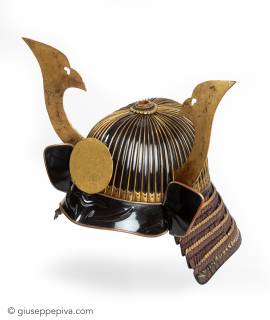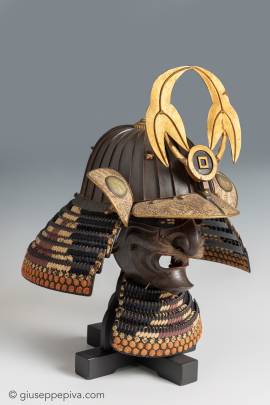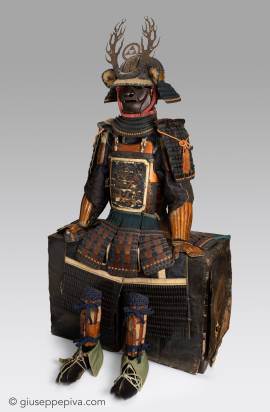Mid-Edo period (1615-1687)18th centuryThe helmet is of goshōzan shape, slightly raised at the back. It is composed of 62 vertical, slightly convex plates lacquered in black urushi. Each plate is bordered by a gilt copper border in the sō-fukurin style. This style of decoration was introduced by the armorers of the Haruta school during the Muromachi period (1336-1573) for their akoda-nari kabuto and, in addition to the aforementioned fukurin, provides for shaped gilt ornaments at the base of each plate (higaki). The tehen-no-kanamono that adorns the top of the helmet is five-tiered. The visor...
WORKS FOR SALE
Helmet and samurai maskEdo period, early 19th centurySignaturesKabuto: Nisshū ju KanemitsuMenpō: Sukemitsu The 32-plate helmet of suji-bachi type, consisting of 32 iron plates finished in sabiji-nuri, folded upward. On the diagonals are four shiten-no-byo rivets and related hibiki-no-ana.The menpō is beautifully finished, with sharp edges and meticulous decoration.Both the protection of the neck (shikoro) and that of the throat (tare) are bound with silk of three colors, echoing the omodaka (sagittaria leaf) motif popular between the twelfth and thirteenth centuries in ō-yoroi-type armor...
PERIODMid Edo period (1615-1867), 18th century EXHIBITIONS"Samurai - Passato e Presente", Novara 2012LITERATUREG.Piva - S. Verrina, Samurai - Passato e Presente, cat. A2, Novara 2012 This authentic samurai armor of tosei gusoku type brings the coat of arms (kamon) with fish scale (uruko) design used by the Hirano clan, daimyō of Tawaramoto in Yamato province. The twelve-plates kabuto (helmet) of "pumpkin" shape (akoda-nari) is typical of this region, richly decorated with byakudan gold lacquer and...
Copyright © 2016 - giuseppe piva - VAT: 05104180962










